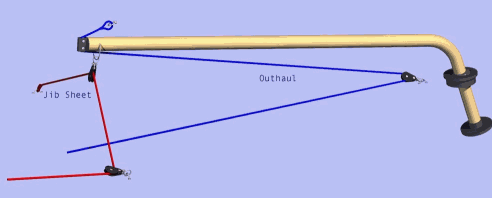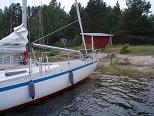Head sail rearrangement
At Seskarö in N. Gulf of Bothnia
Hoyt boom
Hoyt jib boom is a development by American designer Garry Hoyt. It is used e.g. on Alerion Express and Island Packet yachts. The main benefit of this boom design is that the jib keeps its shape not only on close reach but also at more open winds, all the way to down wind. This compensates for a good part for the smaller sail area of the jib as compared with full size genoa head sails. Additionally, the sail is self-tending which is a bonus for solo sailors.
The boom looks a bit like a hockey stick (below here in another boat):

The looks of a boom on the fore deck can be discussed. The Hoyt boom of ’MyWay’ is an aftermarket package made by Sparcraft. It is meant to be mounted on deck. In ‘MyWay’ the boom pivot point is bolted to a horizontal support beam in the sail locker some 30 cm below the fore deck, mainly because the sandwich deck did not appear strong enough for the expected loads, and there already was a suitable hole in the deck. This way the skirt of the sail is also a bit closer to the deck. The support beam is bolted from below to the bulkheads and toe rails. The arrangement can be dismantled without any major traces, should the trial prove to be non-satisfactory.

The boom has two trim sheets: the jib sheet for the boom and sail angle, and the outhaul for the sail shape.
The sheets are lead back to the cockpit. A new jib with vertical battens and some roach was cut with the proper dimensions to fill the fore sail triangle.
The boom swings clear over the guard rail lines so they did not need any modifications, but the longish pulpit of Wasa 55 was shortened at its rear part.
Genoa sails
While re-laying the teak deck, I left the genoa lead rails out
completely (you always hit your toe to the genoa lead car when moving to
the fore deck…). If at some point of time I’d like to use a G2 or G1, it
can be swapped to the Furlex and the lead blocks attached to the toe
rails. Of course, the genoa lead rails can be mounted back, should it
become to that. Sofar, however, the larger genoas have not been
used after the boom was installed. and a furling gennaker was procured as
substitute.
First hand experiences
On basis of some ten summers of sailing, following comments about the Hoyt boom on a Wasa 55:
- The 'boomed' head sail is really easy in use: when tacking, I now only have to take care of the running back stays (and, with a reef in the main sail, not even that).
- The boom functions quite well on all headings; when dead down wind at mild winds, a preventer would be needed to keep the boom 'wing-a-wing'
- The jib size head sail makes the going sluggish in mild winds: a 'Code 0' sail would be a nice complement for the light winds, if in a hurry...
- The boom is a little in the way on the fore deck, but it also offers a good support point when moving around.
Furling gennaker
For the light winds where the jib does not have enough power, I ordered a Doyle 'UPS' furling gennaker. It gives good drive and goes reasonably high into the wind. The furled sail 'sausage' is easy to hoist single-handedly, and to take down and pack away into its 'turtle' sail bag when not in use. Handling and sailing the gennaker is more or less what I expected. At mild winds, the 65 sq.m. give a substantial power and speed increase, reducing the urge for dieseling. In light winds, the sail points high enough into wind if needed, but is not quite a 'Code 0' type genoa substitution.
I use a Facnor furler where the furling rope loop can be inserted or removed from the furler and left permanently in place when the sail and furler are packed. The endless loop of the furling rope is lead back to the cockpit. The furled sail is better taken down at the end of each gennaker leg because the 'sail sausage' has a tendency to partly unfurl at the top part and start flapping in the wind. Alternatively, a top-down furler could be installed.
The original partial rig of Wasa 55 does not likely carry a full mast top gennaker without some reinforcements. As I did not want to add more spreaders to the old rig, the mast top furler idea was abandoned. Instead, the spi halyard box was relocated some 70 cm higher, which places the gennaker in front of the jib and fore stay, making handling easier and giving a bit cleaner wind to the sail.
The boom foot is supported below deck
![]()


